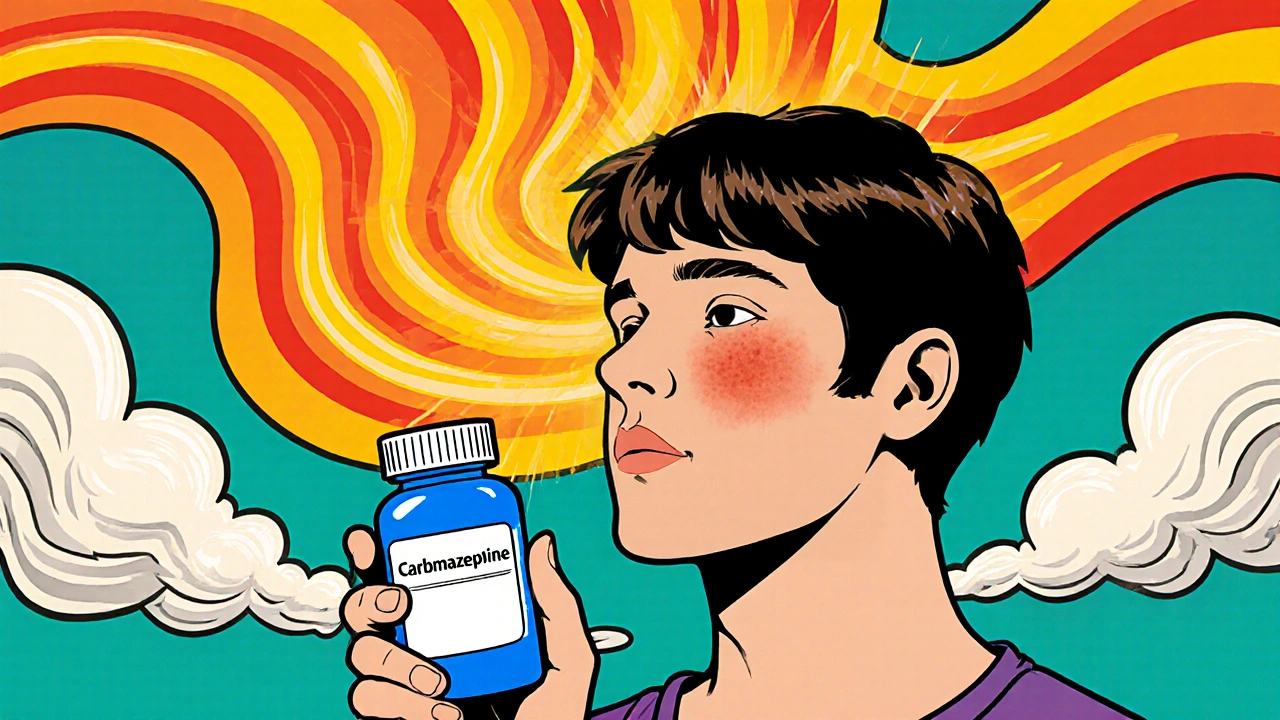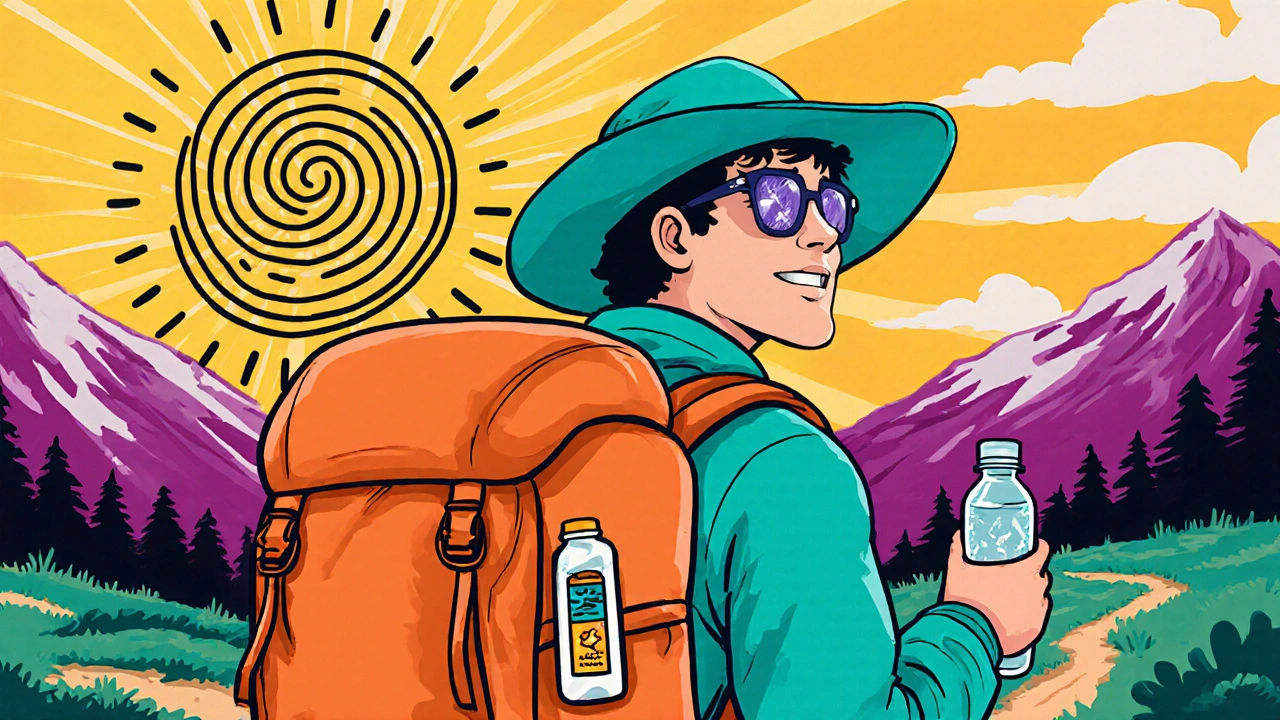
When you take Carbamazepine, a widely prescribed antiepileptic medication, you might notice your skin reacting more strongly to sunlight. This condition, called photosensitivity, can turn a bright day into a health hazard.
What is Carbamazepine?
Carbamazepine belongs to the class of drugs known as dibenzazepine anticonvulsants. It’s approved for treating epilepsy, trigeminal neuralgia, and mood‑stabilization in bipolar disorder. Typical doses range from 200 mg to 1,200 mg per day, and blood‑level monitoring is common because the drug has a narrow therapeutic window.
Why Does Carbamazepine Cause Photosensitivity?
The exact mechanism isn’t fully understood, but research shows that carbamazepine metabolites can linger in the skin and absorb ultraviolet (UV) energy. When UV‑A or UV‑B rays hit the skin, these metabolites become excited and trigger an inflammatory response similar to a mild sunburn. The result is redness, itching, or even blistering after only brief sun exposure.
Who Is Most at Risk?
- People with fair skin (Fitzpatrick skin types I‑II)
- Patients taking higher doses (>800 mg/day) or combining carbamazepine with other photosensitizing drugs (e.g., tetracyclines, thiazides)
- Individuals who spend a lot of time outdoors for work or recreation
- Those with a history of sunburns or skin cancer

Practical Sun‑Safety Strategies
- Apply sunscreen correctly. Use a broad‑spectrum sunscreen with SPF 30 or higher. Apply 1 ounce (about a shot glass) to all exposed skin 15 minutes before heading out, and reapply every two hours or after swimming.
- Sunscreen type matters. Mineral (zinc oxide, titanium dioxide) formulas sit on top of the skin and are less likely to cause irritation for sensitive users; chemical filters (avobenzone, octocrylene) absorb UV rays but can sting if the skin is already inflamed.
- Wear protective clothing. Long‑sleeve shirts made of tightly woven fabric, wide‑brim hats, and UV‑blocking sunglasses reduce direct exposure dramatically.
- Seek shade during peak UV hours (10 a.m.-4 p.m.). If you must be outside, use an umbrella or a pop‑up shelter.
- Stay hydrated. Dehydrated skin recovers slower from UV damage.
Choosing the Right Sunscreen
| Property | Mineral (Physical) | Chemical (Organic) |
|---|---|---|
| Active ingredients | Zinc oxide, titanium dioxide | Avobenzone, octocrylene, homosalate |
| UV protection | Broad‑spectrum, reflects UV | Absorbs UV, needs stable formulation |
| Skin feel | Often a thin white cast | Usually invisible |
| Best for | Sensitive or photo‑reactive skin | Everyday use, no white residue |
| Re‑application frequency | Every 2 hours | Every 2 hours (or after swimming) |
In‑Depth Tips for Different Lifestyles
Outdoor workers (construction, farming, landscaping): Consider a high‑SPF (50+) mineral sunscreen that can stand up to sweat. Wear UPF‑rated clothing-these garments have a built‑in UV protection factor of 30‑50.
Recreational athletes (running, cycling, hiking): Choose a water‑resistant formula with a minimum SPF 30. Pack a travel‑size sunscreen in your gear bag for quick re‑applications.
Travelers to high‑altitude or equatorial destinations: UV intensity can be 30‑40% stronger. Increase SPF by two grades (e.g., from SPF 30 to SPF 50) and double the re‑application frequency.

When to See a Dermatologist or Your Prescribing Doctor
- If you develop persistent redness, blistering, or a rash that doesn’t improve after 48 hours of sun avoidance.
- When you notice a new mole or change in an existing mole-photosensitivity can mask early skin‑cancer signs.
- If you need to adjust your carbamazepine dose because the side‑effect burden outweighs seizure control.
Your doctor may switch you to an alternative antiepileptic (e.g., lamotrigine) or add a protective medication such as niacinamide, which has shown modest UV‑protective properties in clinical trials.
Quick‑Reference Checklist
- ✔ Use broad‑spectrum sunscreen SPF 30+ (prefer mineral if skin is reactive).
- ✔ Apply sunscreen 15 minutes before exposure; reapply every 2 hours.
- ✔ Wear UPF clothing, wide‑brim hat, and UV sunglasses.
- ✔ Avoid sun between 10 a.m. and 4 p.m.; seek shade when possible.
- ✔ Keep skin moisturized and stay well‑hydrated.
- ✔ Monitor skin for unusual reactions; contact a dermatologist promptly.
Mini‑FAQ
Can I still take carbamazepine if I love outdoor activities?
Yes, but you must be diligent about sun protection. Choose a high‑SPF mineral sunscreen, wear UPF clothing, and schedule outdoor time outside peak UV hours.
Does wearing a hat replace sunscreen?
No. A hat protects the scalp and face, but the rest of the body remains exposed. Combine hat use with sunscreen for full coverage.
Is there a test to know if I’m photosensitive?
A phototest performed by a dermatologist can measure skin reaction to controlled UV exposure. It’s useful if you’ve had unexplained rashes.
Can other medications worsen carbamazepine‑induced photosensitivity?
Yes. Drugs like tetracycline antibiotics, thiazide diuretics, and certain non‑steroidal anti‑inflammatory drugs (NSAIDs) have their own photosensitizing potential and can amplify the effect.
Should I stop carbamazepine if I get a sunburn?
Do not stop abruptly without medical advice; sudden discontinuation can trigger seizures. Contact your prescriber to discuss dose adjustment or alternative therapy.
By understanding how carbamazepine photosensitivity works and following these sun‑safety steps, you can keep enjoying the outdoors while keeping your skin healthy.
9 Comments
Robert Gilmore October 24, 2025 AT 22:29
Hey everyone! 🌞 If you’re on carbamazepine and notice extra redness, remember that sunscreen isn’t just a summer luxury – it’s a daily shield. Apply a generous layer of mineral SPF 30+ at least 15 minutes before stepping outside, and re‑apply every two hours, especially after sweating or swimming. Pair that with UPF‑rated clothing, a wide‑brim hat, and a pair of UV‑blocking shades for full‑body coverage. Staying hydrated and using a gentle moisturizer can also help your skin recover faster. You’ve got this, and we’ll keep the sun safe together! 😊
Robert Gilmore October 26, 2025 AT 15:09
Think of sunscreen as your skin’s armor, and reapply like you’d reload a weapon.
Robert Gilmore October 28, 2025 AT 08:49
Stop ignoring the science – carbamazepine metabolites literally sit in your epidermis and act like tiny UV antennas. That means every stray ray can trigger inflammation faster than a regular sunburn. The only effective defense is a broad‑spectrum mineral sunscreen with at least SPF 30, applied thickly and re‑applied religiously. Add UPF clothing and you’ll slash the risk by over 80 %. If you keep skipping these steps, you’re basically begging for a rash or worse, a skin‑cancer precursor.
Robert Gilmore October 30, 2025 AT 02:29
i cant belive the gov't doesnt tell us that carbamazepine make us like a living solar panel they keep hidein the info
Robert Gilmore October 31, 2025 AT 20:09
The guide paints a rosy picture, but it skimps on the fact that many patients can’t afford high‑SPF mineral sunscreens, leading to a false sense of security. Moreover, the checklist ignores drug interactions that amplify photosensitivity, such as thiazides, which are common in hypertensive patients on carbamazepine. It also fails to mention that chronic exposure can mask early melanoma signs, a serious oversight. In short, the article is well‑intentioned but dangerously incomplete.
Robert Gilmore November 2, 2025 AT 13:49
Utilize UPF garments and maintain regular sunscreen reapplication for optimal protection
Robert Gilmore November 4, 2025 AT 07:29
Yo, i been taking carbamazepine for months and i swear the sun feels hotter. Gotta slapp that mineral sunscreen on every morning, no excuses. Also, a big hat and some shade breaks can save your skin from turning into a lobster.
Robert Gilmore November 6, 2025 AT 01:09
Another generic article about sunscreen; they could've just said “stay indoors”.
Robert Gilmore November 7, 2025 AT 18:49
I have read countless medical pamphlets that pretend to be helpful, and this one is no different. The author lists obvious advice such as “wear a hat” and “apply sunscreen”, which any teenager learns in middle school. Yet the text fails to address the underlying socioeconomic barrier that makes mineral SPF 50 creams unaffordable for many. When a patient cannot purchase the recommended product, the guidance becomes a cruel joke. Furthermore, there is no mention of the role of vitamin D deficiency that can arise from excessive shade seeking. Patients need a balanced approach, not an all‑or‑nothing directive. The checklist also ignores the fact that carbamazepine can cause photosensitivity at lower doses in genetically predisposed individuals. Genetic testing is mentioned in specialist journals but never translated into practical advice here. The tone of the article is overly cheerful, as if sunburns are a minor inconvenience rather than a potential trigger for severe skin disorders. It would have been prudent to advise readers to keep a log of sun exposure and skin reactions. Such a log could help clinicians adjust dosages more intelligently. In summary, while the guide is polite and well‑structured, it is fundamentally shallow and neglects the realities faced by patients on carbamazepine.